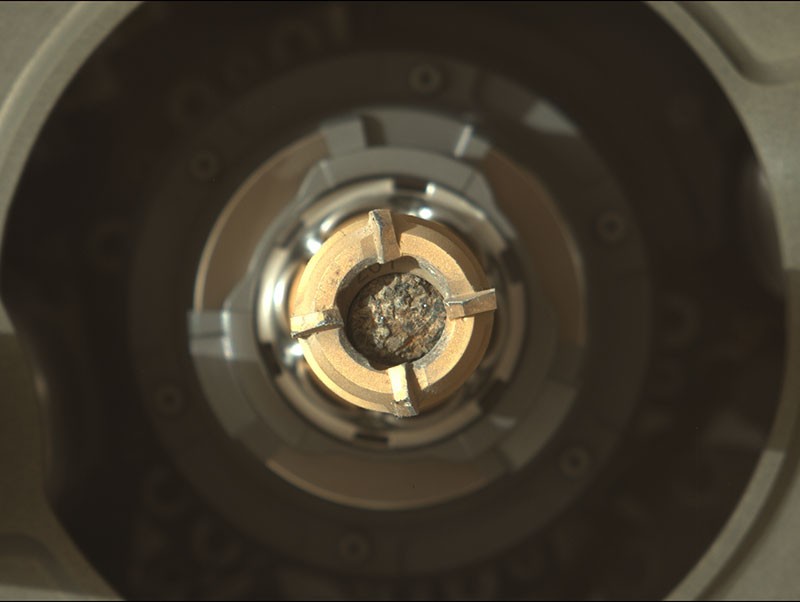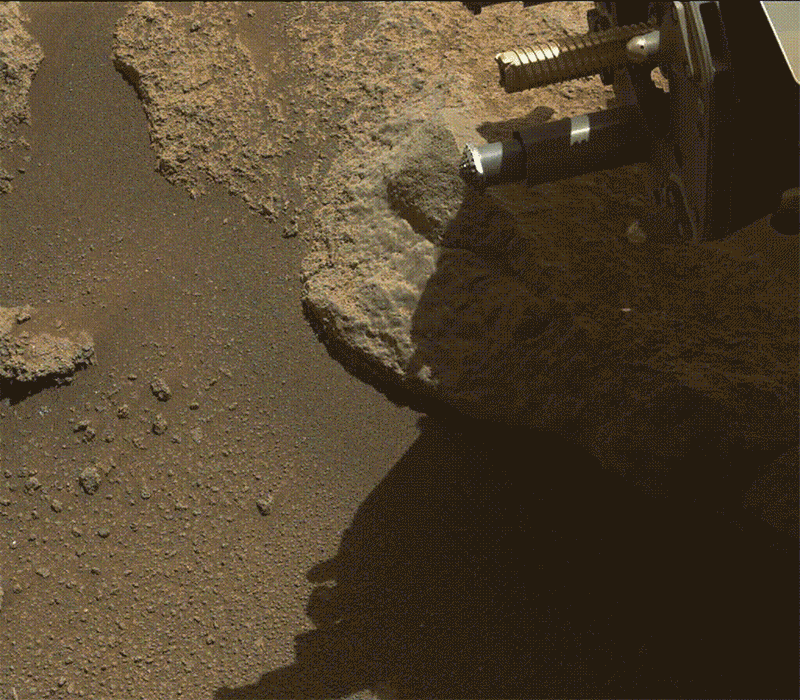Since landing on Mars one year ago, NASA’s Perseverance rover has travelled more than 3 kilometres across rocky terrain, recorded the first flight on the planet by a helicopter and collected six precious rock samples that — if all goes well — will one day be returned to Earth, along with many more, for study.
Perseverance touched down in Jezero Crater, just north of the Martian equator, on 18 February 2021 with the goal of searching for signs of past life. Researchers intended the US$2.7-billion rover to look for these signs in an ancient delta, where a river that once flowed into the crater deposited sediments and rocks — an environment that could have supported life. But the rover hasn’t reached it yet.
Instead, Perseverance has spent the year rolling around the bottom of the crater, making a host of surprising discoveries — one of which is that Jezero’s floor is made of igneous rocks. These formed as molten rock cooled and solidified billions of years ago. Some researchers had thought that the crater floor would be made of sedimentary rock, created as wind or water deposited layers of sediment over time. But the rover found a different history for the landscape.
Igneous rocks are important because scientists can analyse the radioactive decay of elements inside them to determine how old the rocks are. If and when Perseverance’s samples come back to Earth, researchers will be able to date rocks from specific places on the surface of Mars for the first time.
Before the rover landed, mission scientists didn’t know they were going to hit an igneous jackpot. “Jezero delivered,” says Katie Stack Morgan, the mission’s deputy project scientist at the Jet Propulsion Laboratory in Pasadena, California.
A fiery past
Scientists discovered that Jezero’s floor wasn’t what they expected when the rover began preparing to drill its first sample in August. Exploring the area’s geology, Perseverance ground into a piece of Martian rock to reveal a fresh surface. It looked like an igneous rock on Earth that had salt-rimmed holes in it — holes that had probably formed as water flowed through the rock. That meant the rover was looking at an ancient volcanic rock that had interacted with water, indicating a life-friendly environment such as had never been seen on Mars. “That was a great moment for the mission,” says Stack Morgan. “Those are ideal places to be looking for signs of ancient rock-hosted life.”
But when Perseverance tried to drill a core, the material crumbled and slid out of the sampling device. Because the sampling procedure was automated, the rover ended up with an empty but sealed tube, which mission scientists tried to put a positive spin on, labelling it a sample of Mars’s atmosphere.
“You can’t really give Mars a wish list,” says Tanja Bosak, a geobiologist at the Massachusetts Institute of Technology in Cambridge. “Mars gives you what it wants to give you.”
A month later, Perseverance successfully drilled its first pair of cores, into a similar igneous rock that had been altered by water (see ‘Sampling Mars’). This rock formation, called Maaz, covers much of Jezero’s floor.
The rover then drove south and west, skirting a dune-ridden area called Seitah, and collected two more pairs of samples. (It collects pairs to increase the potential that one of the samples will be returned to Earth.) Mission scientists had thought that Seitah’s rocks would be sedimentary, because visually they seemed to be composed of different layers. But as soon as Perseverance ground away at some of the Seitah rocks, another surprise emerged. They, too, were igneous.
Using various instruments to analyse the rocks’ chemical composition, Perseverance found chunky grains of one mineral, called olivine, encased in another, called pyroxene. These minerals are generally found in igneous rocks or volcanic areas on Earth. That’s strong evidence that the Seitah rocks formed as a large body of molten rock cooled, says Stack Morgan. Olivine crystals would have formed first, and sunk towards the bottom of the cooling magma, and then pyroxene would have formed around them — creating layered rocks that appear sedimentary.
The Seitah rocks, like the Maaz rocks, also show signs of having interacted with water in the past. They might even — as reported at a December meeting of the American Geophysical Union by Eva Scheller, a geologist at the California Institute of Technology in Pasadena — contain organic molecules, probably produced through non-biological processes, such as those seen in some Martian meteorites.
Pressure mounts
All told, Perseverance is supposed to collect at least 30 rock, dirt and atmosphere samples. It will lay them down in one or more places for future missions to retrieve, in what could be the first sample return from Mars. Getting the cores to Earth will be an elaborate process requiring another rover to pick them up, a rocket to launch them into Mars orbit, and a spacecraft to capture them and fly them back to Earth; this would happen no earlier than 2031. NASA and the European Space Agency are collaborating on the plan, and NASA announced this month that it had chosen a contractor to build the rocket that will lift the samples into Mars orbit.
“I’m just super-excited that we’re finally taking the first steps towards collecting and hopefully bringing back samples from Mars,” says Meenakshi Wadhwa, a planetary scientist at Arizona State University in Tempe and NASA’s principal scientist for the Mars sample-return programme. “We already have some really great samples to assess the question of whether there was ancient life.”
Despite the rover’s success so far, pressure is mounting for it to get to the long-awaited delta. Perseverance is making its way there now as quickly as possible; earlier this month, it set a record for long-distance driving on Mars, travelling more than 240 metres in a day. Even so, it probably won’t get to the delta until April.
Time is of the essence because Perseverance has only about one Earth year remaining to meet the timetable for accomplishing its main to-do list: get to the delta, collect samples there, and drive up onto the crater rim to place them somewhere for pick-up. The rover is currently retracing its steps towards its landing site: it will collect another pair of cores from Maaz along the way, and then detour around the dune-filled region to reach the delta. Perseverance is working at a much faster pace than NASA’s previous Mars rover, Curiosity, which has been exploring Gale Crater since it landed in 2012. “We have to keep on moving,” Bosak says.
Although operations have mostly been smooth, some small glitches have occurred, besides the initial failed attempt to collect a rock core. In December, some pebbles fell out during a coring attempt and jammed some of the mechanisms in the rover’s sampling equipment. Engineers eventually got Perseverance to shake the pebbles loose to fix the problem. And in recent weeks, says José Antonio Rodríguez Manfredi, principal investigator of the rover’s weather instrument at the Centre for Astrobiology in Madrid, surprisingly strong winds kicked dust and small pebbles into several of the rover’s wind sensors, damaging them.
Perseverance’s sidekick, the tiny helicopter named Ingenuity, continues to plug along. Researchers intended the craft to make five flights over 30 days. But it has so far made 19 flights and travelled more than 3.8 kilometres. It is currently staged ahead of the rover and will be used, if it continues to survive, to scout routes that the rover might take once it gets to the Jezero delta to collect more cores.
“The delta samples will be spectacular,” Bosak says. “I can’t wait. I really can’t wait.”

